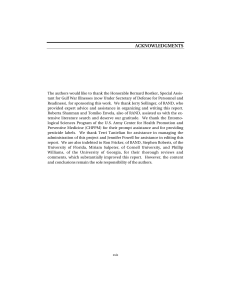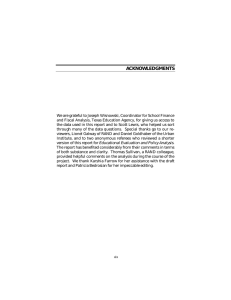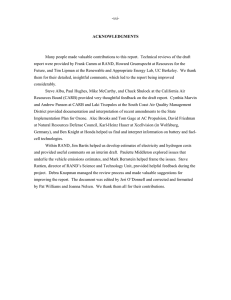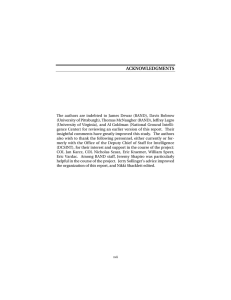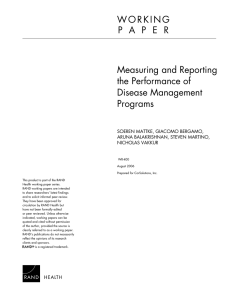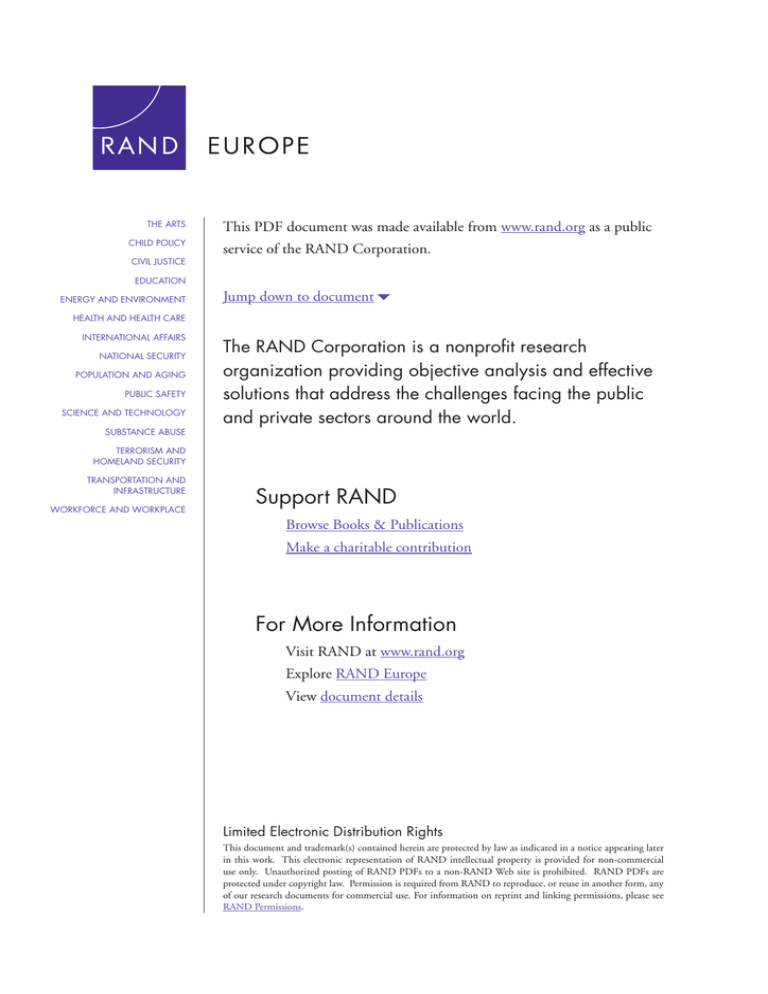
THE ARTS
CHILD POLICY
CIVIL JUSTICE
This PDF document was made available from www.rand.org as a public
service of the RAND Corporation.
EDUCATION
ENERGY AND ENVIRONMENT
Jump down to document6
HEALTH AND HEALTH CARE
INTERNATIONAL AFFAIRS
NATIONAL SECURITY
POPULATION AND AGING
PUBLIC SAFETY
SCIENCE AND TECHNOLOGY
SUBSTANCE ABUSE
The RAND Corporation is a nonprofit research
organization providing objective analysis and effective
solutions that address the challenges facing the public
and private sectors around the world.
TERRORISM AND
HOMELAND SECURITY
TRANSPORTATION AND
INFRASTRUCTURE
WORKFORCE AND WORKPLACE
Support RAND
Browse Books & Publications
Make a charitable contribution
For More Information
Visit RAND at www.rand.org
Explore RAND Europe
View document details
Limited Electronic Distribution Rights
This document and trademark(s) contained herein are protected by law as indicated in a notice appearing later
in this work. This electronic representation of RAND intellectual property is provided for non-commercial
use only. Unauthorized posting of RAND PDFs to a non-RAND Web site is prohibited. RAND PDFs are
protected under copyright law. Permission is required from RAND to reproduce, or reuse in another form, any
of our research documents for commercial use. For information on reprint and linking permissions, please see
RAND Permissions.
This product is part of the RAND Corporation technical report series. Reports may
include research findings on a specific topic that is limited in scope; present discussions of the methodology employed in research; provide literature reviews, survey
instruments, modeling exercises, guidelines for practitioners and research professionals, and supporting documentation; or deliver preliminary findings. All RAND
reports undergo rigorous peer review to ensure that they meet high standards for research quality and objectivity.
The affordability of
alcoholic beverages in
the European Union
Understanding the link
between alcohol affordability,
consumption and harms
Lila Rabinovich, Philipp-Bastian Brutscher,
Han de Vries, Jan Tiessen,
Jack Clift, Anais Reding
Prepared for the
European Commission DG SANCO
EUROPE
The research described in this report was prepared for the European Commission. The
opinions expressed in this study are those of the authors and do not necessarily reflect the
views of the European Commission.
The RAND Corporation is a nonprofit research organization providing objective analysis
and effective solutions that address the challenges facing the public and private sectors
around the world. RAND’s publications do not necessarily reflect the opinions of its
research clients and sponsors.
R® is a registered trademark.
© Copyright 2009 European Commission
All rights reserved. No part of this book may be reproduced in any form by any electronic or
mechanical means (including photocopying, recording, or information storage and retrieval)
without permission in writing from the European Commission.
Published 2009 by the RAND Corporation
1776 Main Street, P.O. Box 2138, Santa Monica, CA 90407-2138
1200 South Hayes Street, Arlington, VA 22202-5050
4570 Fifth Avenue, Suite 600, Pittsburgh, PA 15213-2665
Westbrook Centre, Milton Road, Cambridge CB4 1YG, United Kingdom
RAND URL: http://www.rand.org
RAND Europe URL: http://www.rand.org/randeurope
To order RAND documents or to obtain additional information, contact
Distribution Services: Telephone: (310) 451-7002;
Fax: (310) 451-6915; Email: order@rand.org
Executive summary
The European Commission (EC) commissioned RAND Europe to conduct a study on the
affordability of alcohol products across the EU, and on the potential impacts of
affordability on harmful use of alcohol. On this basis, the study is intended to provide
evidence on whether alcohol affordability could be a useful policy lever to public
authorities seeking to reduce harmful alcohol consumption in Europe. This section
highlights some of the main findings of the research.
There is increasing pan-European interest in developing and implementing measures to
combat alcohol harms
Alcohol is an important economic commodity in Europe, creating jobs, generating fiscal
revenues in the form of alcohol taxes, and contributing around €9 billion to the EU’s
economy through trade. But while alcohol has been, and continues to be, consumed in an
unproblematic way by many people, a significant proportion of alcohol consumption is
problematic and generates harms for individuals and societies. Alcohol is the third leading
risk factor for death and disability in the European Union (EU) after tobacco and high
blood pressure. Europe has the highest proportion of drinkers and the highest levels of
alcohol consumption per head of the population in the world, with total alcohol
consumption averaging eleven litres of pure alcohol a year per adult. These high levels of
alcohol consumption recorded in the EU have been linked to a number of public health
and other problems, including violence and crime, diseases such as lover cirrhosis, lost
productivity and absenteeism, family breakdown and accidental death. Through these
harms, alcohol misuse generates high costs to society. It was estimated that the costs in the
EU of alcohol misuse was around €125 billion in 2003, equivalent to 1.3% of gross
domestic product (GDP). This exceeds by an order of magnitude the reported
contribution (about €9 billion) of the alcohol industry to the EU economy.
There has been a decline in the real value of alcohol excise duty rates across the EU
The real value of excise duty rates for most alcoholic beverages has gone down since 1996
in the vast majority of EU Member States. Notable exceptions are the UK and Italy, which
have seen an increase in the real value of excise duty rates for beer; with an increase for
wine too in the UK. There has also been a decline in the EU minimum excise duty rates in
real terms for alcoholic beverages since 1992 as they have not been adjusted for inflation.
There is a trend across the EU towards more off-trade alcohol consumption
There is a trend across the EU towards more off-trade alcohol consumption, which tends
to be cheaper than alcohol sold on-trade. On-trade refers to pubs, clubs, restaurants and
xiii
other retailers selling alcohol for consumption within the venue. Off-trade refers to
supermarkets and off-licences, selling alcohol for consumption elsewhere. These are also
referred to as on-premise and off-premise sales of alcohol. In countries such as the UK,
Sweden, Finland, Latvia, Ireland and The Netherlands, off-trade alcohol sales appear to be
growing relative to on-trade. This is true even in those countries in which the market share
of the on-trade has traditionally been larger, such as Ireland and The Netherlands.
Although there is little research examining this particular question, it is possible that one of
the main reasons for the increase in off-trade alcohol consumption is the lower prices of
alcohol in the off-trade retailing. In many of the countries mentioned above, alcohol prices
in the off-trade appear to be decreasing relative to on-trade prices.
Alcohol has become more affordable across the EU since 1996
The affordability of alcohol is a composite measure looking at the net effect of price and
income. The affordability of alcoholic beverages has increased in all countries examined,
apart from Italy; that is, in nearly all countries examined alcohol has become more
affordable over the last twelve years.1 In six countries (Lithuania, Estonia, Latvia, Finland,
Slovakia and Ireland) affordability of alcohol increased by 50% or more. The figure below
shows the change in affordability of alcohol since 1996 for the twenty countries for which
data are available.
300
Affordability Index 2004
250
200
Affordability Index 2004
150
100
lt ee lv uk cz fi sk ie pt es dk se fr at nl gr de pl be it
50
0
Member State
1
The fact that the affordability of alcohol in Italy has actually decreased over the time period studied here may
reflect changes in alcohol consumption in the country in the last few decades. Overall alcohol consumption has
declined considerably since the 1970s in Italy, traditionally a wine-drinking country, driven primarily by a
decline in wine consumption (Simpura 1998). As a result, it has been argued that a response from the wine
industry has been to switch from the production of cheaper wines (which were a ‘necessity’ for Italian
consumers who used to drink wine with their meals) to the production of more expensive, luxury wines (A.
Allamani, personal communication), thus leading to a decrease in the affordability of alcohol.
xiv
RAND Europe
The affordability of alcoholic beverages in the EU
SOURCE: Eurostat, author calculations
Figure 1: Changes in the affordability of alcohol between 1996 and 2004, selected EU countries
Our analysis indicates that across the EU, 84% of the increase in alcohol affordability was
driven by increases in income, and only 16% was driven by changes in alcohol prices.2
This is primarily because while incomes went up considerably across the EU, the relative
price of alcoholic beverages has remained relatively stable, or fallen at a lower rate than the
income increases, in most of the EU countries included in this analysis.
There is a positive relationship between alcohol affordability and alcohol consumption in
the EU
The balance of existing evidence indicates that there is a negative relationship between
alcohol price and consumption, and a positive relationship between income and
consumption. In accordance with these findings, our own analysis indicates that there is a
statistically significant positive relationship between alcohol affordability (a composite
measure looking at the effect of price and income) and consumption across the EU. More
specifically, we find a short run elasticity of 0.22 and long-run elasticity of 0.32 (suggesting
a total increase in consumption of 0.32% following a 1% increase in affordability). These
elasticities are symmetrical; i.e. a 1% increase in affordability in the short-run has the same
effect as a 1% decrease in affordability in the short-run.
This additional evidence on the positive association between affordability and
consumption in Europe contributes to the growing understanding of the way in which
drinkers respond to changes in how affordable alcoholic beverages are. The body of
research on this issue contributes to an evidence base on alcohol pricing policy.
There is a positive relationship between alcohol consumption and three types of harms:
liver cirrhosis, traffic injuries and traffic deaths
Our analysis suggests positive, statistically significant associations between alcohol
consumption and three indicators of harm: fatal traffic accidents, (non-fatal) traffic injuries
and liver cirrhosis. More specifically, we find that a 1% increase in per capita alcohol
consumption is associated with an increase of 0.85% in fatal traffic accidents, 0.61% in
traffic injuries, and 0.37% in the incidence of liver cirrhosis within the same year. We do
not find a statistically significant association between alcohol consumption and homicide
at the aggregate level.
Our findings support those of existing research on the link between alcohol consumption
and these three types of harms. As discussed earlier in this chapter, there is substantial and
robust evidence for this association, to which our own analysis contributes.
Our evidence - in combination with the existing body of research on the link between
alcohol price/income/affordability and consumption, and on the direct link between
alcohol price/income and harms - provides strong support for the use of alcohol pricing
2
The calculation is based on a double-log regression of the affordability index on the price index and income
index – suppressing the constant term.
xv
policies as a potentially effective measure to curb hazardous and harmful drinking in
Europe.
Cross-border alcohol shopping for personal use has negative implications for the
‘importing’ country
We conducted three case studies on cross-border alcohol consumption for personal use.
The case studies were: UK-France, Finland-Estonia, and Sweden-Denmark-Germany. In
all these examples there are significant differences in alcohol taxation and price between the
countries, and these have combined with reductions in controls on imports for personal
use leading to increases in cross-border alcohol consumption. In the case of Finland and
Denmark in particular, the advent of lighter controls on alcohol imports for personal use
were met with reductions in alcohol taxation with the aim of preventing greater losses in
the demand for alcohol and thus protecting the national tax base.
Cross-border shopping increased significantly in these three cases following the reduction
of controls on imports for personal use. The cross-border purchases not only reduce the tax
revenues that can be collected by national tax authorities; there is also evidence that
increased cross-border purchasing has led to an increase in consumption in the receiving
countries, especially Finland and Sweden. This suggests consumers did not simply change
the location of their alcohol purchases, but also increased their total alcohol consumption.
However in some of the case studies consumption seems to have levelled off or even
dropped somewhat once consumers adjusted to the availability of cheap alcohol in
neighbouring countries, a phenomenon witnessed in Sweden and to a lesser extent in
Finland.
Importantly, there is evidence of a relationship between the reduction of controls on
imports for personal use and alcohol-related harms in the countries examined here. The
evidence for this is robust in Finland, suggestive in Sweden, but still inconclusive in the
UK.
The findings from this analysis refer to three case studies of cross-border alcohol
consumption between countries sharing sea borders. It is unclear from this analysis
whether these findings would be replicated in studies of cross-border consumption
between other neighbouring EU countries with significant alcohol tax differentials. It is
possible that countries with significant tax or price differentials sharing land borders
experience even higher levels of cross-border alcohol shopping, although further research
would be needed to ascertain this.
Alcohol pricing policies are not always used towards public health aims across the EU
Existing research has shown that alcohol pricing policies can be effective levers to reduce
alcohol-related harms. However, these policies are not always applied to public health aims
across the EU. Taxation of alcohol, for example, is used primarily with fiscal rather than
public health objectives across most of the EU; in fact, as our analysis shows, the real value
of alcohol taxation has decreased since the mid-1990s.
Legislation setting minimum prices for alcohol, which could potentially reduce alcoholrelated harms, is also uncommon in the region. This is most likely because minimum
prices have tended to be seen as trade-distorting by the European courts (as setting an
artificial price floor amounts to resale price maintenance, limiting and distorting price
xvi
RAND Europe
The affordability of alcoholic beverages in the EU
competition), and therefore not typically considered an acceptable or feasible measure.
Nevertheless, there are regulations in a small number of European countries (both EU and
other European states) that act as ‘proxies’ for minimum price regulations. For example, in
Germany, the so-called Apple Juice law states that in the on-premise trade, at least one
alcohol-free beverage must be cheaper than the cheapest alcoholic beverage available.
The approach to restrictions on sales below cost and on sales promotions such as ‘two for
one’ and ‘happy hour’, is much more diverse across the EU. While some countries (such as
Belgium, Luxembourg and Poland) ban sales below cost and/or alcohol sales promotions,
in others there are no regulations applying to these, or self-regulation only is in place.
Changes in current alcohol pricing policy could lead to reductions in alcohol-related
harms – but some of them are more feasible than others
Policy changes to reduce current levels of alcohol-related harms could be implemented at
the EU or national level, such as increases in alcohol excise duties, reductions in the
personal import limits or control of below cost and promotional sales. However, changes at
the EU-level, such as meaningful increases in the minimum excise duty rates or revisions to
the indicative levels for personal use for cross-border alcohol purchases, seem highly
unlikely in view of the pre-eminence of single market priorities, and the need for consensus
by all MS in EU fiscal policy. Increases in taxation at the national level could be an
effective strategy to reduce alcohol-related harms, but their feasibility in the current
European context is compromised by downward pressure on taxes caused by the single
market, and by the strength of the opposition to tax increases.
This leaves restrictions on sales below cost and on sales promotions, which could also be
effective in curbing alcohol-related harms, but are not widespread across the EU. These
types of measure are unlikely to be deemed trade-restrictive, which should enable MS to
implement this policy without contravening of EU law. Equally, from a legal perspective,
bans on sale below cost could be part of industry self-regulatory codes of practice, although
they are not yet widespread in current self-regulation initiatives. However, in most EU MS
it is not known exactly how much alcohol is sold below cost, so the overall impact of this
policy remains uncertain.
It is important to understand the influence of price and affordability on alcohol
consumption and harms in order to inform effective policy-making
Understanding the influence of individual factors such as price or affordability can provide
policy-makers with a variety of tools to achieve the aims of policies to address a public
health concern such as harmful and hazardous alcohol consumption. This and many other
studies indicate that the price and affordability of alcohol do impact on levels of harmful
and hazardous alcohol consumption; hence policy-makers should consider measures
affecting the price of alcohol, and therefore its affordability, to help reduce alcohol related
harms.
Harmful and hazardous alcohol consumption is a multi-factorial problem, so approaches to
influence the price/affordability of alcohol are not the only elements of most countries’
alcohol strategies. Other policies have been shown to be effective in reducing harmful and
hazardous alcohol consumption, such as reducing alcohol outlet density, increasing
xvii
minimum legal drinking ages, and enforcing drink-driving counter-measures. An effective
alcohol strategy is a policy mix that includes evidence-based interventions in all these fields.
xviii

